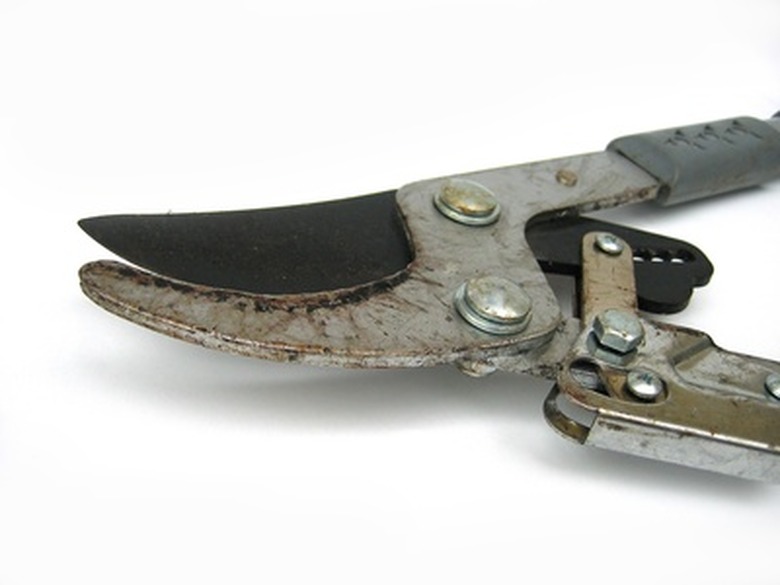How To Sharpen Bypass Loppers
Things Needed
- Wrench
- Lubricant
- Steel wool
- Toothbrush
- Soft, clean cloth rag
- Medium-grit diamond sharpening stone
Sharp garden tools are not only easier to use, but much better for the plants they're cutting. Sharp blades make tidy cuts, whereas dull blades tend to tear and crush stems and branches. Because the sharpening process also involves cleaning of the cutting surfaces, well-maintained bypass loppers also tend to transmit fewer plant diseases. Sharpen hand pruners and bypass loppers at least once a year.
Disassembling and Cleaning Bypass Loppers
Step 1
Loosen the nut from the central fastening bolt by twisting in a counter-clockwise direction with an appropriately sized wrench. Spray with a lubricant, such as WD-40, to ease a stubborn bolt.
Step 2
Separate the cutting blade from the hook side by completely unscrewing the nut from the bolt. Pull the cutting blade side away from the hook side (the non-cutting edge).
- Sharp garden tools are not only easier to use, but much better for the plants they're cutting.
- Because the sharpening process also involves cleaning of the cutting surfaces, well-maintained bypass loppers also tend to transmit fewer plant diseases.
Step 3
Use a toothbrush to clean away particles in the groove of the hook-side of the loppers.
Step 4
Wipe both sides of the loppers clean with a dry cloth.
Step 5
Finish the cleaning with a final polish of steel wool.
Sharpening the Bypass Loppers
Step 1
Hold the handle of the cutting blade section against a flat work surface so that the blade extends past the edge of the work surface. This allows a wide range of movement to work around the blade.
Step 2
Set the edge of the sharpening stone against the cutting edge and file the blade from the base of the lopper blade toward the tip. Filing motions should always be down and away from the body.
- Use a toothbrush to clean away particles in the groove of the hook-side of the loppers.
- Wipe both sides of the loppers clean with a dry cloth.
Step 3
Maintain a consistent angle with the sharpening stone. Altering the angle will round the cutting edge of the blade and make it dull rather than sharp. Run the sharpening stone down the blade until you have achieved a satisfactory edge.
Step 4
Make several passes with the sharpening stone along the reverse side of the cutting blade to remove any metal burrs or rough edges.
Step 5
Reassemble loppers by sliding bolt through the cutter section, followed by the hook section. Lightly tighten the nut over the bolt using your fingers.
To align the cutting edge with the hook section, set the two sections together and tighten the bolt firmly with the wrench. Continue by unscrewing the bolt gradually, by quarter turns, until the loppers just open. Lopper blades should then grind slightly when pushed closed; this is a sign of a proper alignment.
- Maintain a consistent angle with the sharpening stone.
- Make several passes with the sharpening stone along the reverse side of the cutting blade to remove any metal burrs or rough edges.
Tip
For a more precise edge, you may choose to use a sharpening jig. A jig is a swiveling sharpening tool which fastens to the non-cutting side of the blade and uses a small diagonal arm that is threaded through a guide hole. Using a jig eliminates the guesswork of maintaining a consistent sharpening angle.
